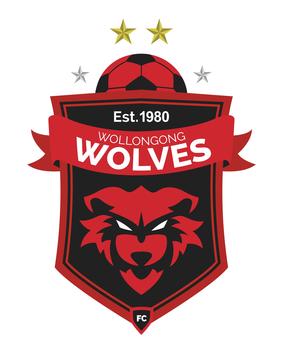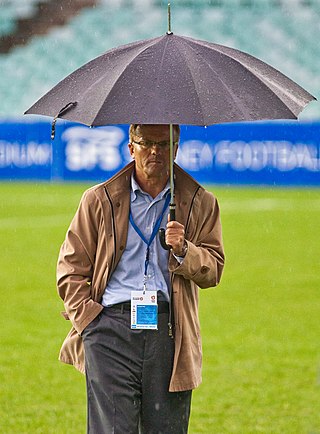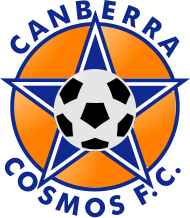
Newcastle United Jets Football Club, commonly known as Newcastle Jets, is an Australian professional soccer club based in Newcastle, New South Wales. It competes in the country's premier competition, the A-League, under licence from the Australian Professional Leagues (APL). The club was formed in 2000 when it joined the National Soccer League (NSL) and was one of only three former NSL clubs to join in the formation of the A-League.

Sydney Olympic Football Club is an Australian semi-professional soccer club, based in Belmore, Sydney, New South Wales, that plays in the National Premier Leagues NSW. The club was founded as Pan-Hellenic Soccer Club in 1957 by Greek immigrants. In 1977, the club changed its name to Sydney Olympic and became a founding member of the Phillips Soccer League, later named the National Soccer League (NSL), the inaugural national football league of Australia, remaining a member of the competition until its demise in 2004.

Wollongong Wolves Football Club is an Australian semi-professional soccer club based in Wollongong, in the Illawarra region of New South Wales. The club currently competes in the National Premier Leagues NSW, the second-tier of soccer in Australia. The club plays its home games at WIN Stadium.

Branko Culina is a soccer coach and former player. He previously managed Sydney FC and the Newcastle Jets in the A-League.

Soccer in the Australian Capital Territory is predominantly amateur with a local, interstate, national and international history. Soccer in the ACT is organised and administered by Capital Football and involves teams from within the ACT and surrounding NSW regions, Monaro, Southern Tablelands and Riverina.
Newcastle KB United are a defunct Australian association football club. They participated in the National Soccer League from 1978 until early in the 1984 season.
The 1996–97 National Soccer League season, was the 21st season of the National Soccer League in Australia.
The Football Kingz were New Zealand's first professional football club. They played in the Australian National Soccer League from 1999 until their disestablishment in 2004, when they were replaced by the New Zealand Knights as an inaugural participant in the newly established Australian A-League.
The 1996–97 NSL Cup was the 21st and final edition of the NSL Cup, which was the main national association football knockout cup competition in Australia. The NSL Cup was sponsored by Johnnie Walker and known as the Johnnie Walker Cup for sponsorship purposes.
The 1995–96 NSL Cup was the 20th edition of the NSL Cup, which was the main national association football knockout cup competition in Australia. The NSL Cup was sponsored by Johnnie Walker and known as the Johnnie Walker Cup for sponsorship purposes.
The National Soccer League Coach of the Year was an annual soccer award presented to coaches in Australia. It recognised the most outstanding manager in the National Soccer League each season. The award was established in the first NSL season, 1977.
This article concerns soccer records in Australia. Unless otherwise stated, records are taken from the National Soccer League or A-League Men. Where a different record exists for the top flight, this is also given.
The 1996–97 season was Collingwood Warriors' only season in their history and in the National Soccer League. In addition to the domestic league, Collingwood Warriors participated in the final NSL Cup. Collingwood Warriors finished 13th in their National Soccer League season, and won the NSL Cup winning 1–0 in the Final against Marconi Fairfield.
The 1995–96 season was the first in the history of Canberra Cosmos. It was also the first season in the National Soccer League. In addition to the domestic league, they also participated in the NSL Cup. Canberra Cosmos finished 9th in their National Soccer League season, and were eliminated in the NSL Cup semi-finals by South Melbourne.
The 1996–97 season was the second in the history of Canberra Cosmos. It was also the second season in the National Soccer League. In addition to the domestic league, they also participated in the NSL Cup. Canberra Cosmos finished 14th in their National Soccer League season, and were eliminated in the NSL Cup Round of 16 by Melbourne Knights.
The 1995–96 season was the fourth season in the history of Newcastle Breakers. It was also the fourth season in the National Soccer League. In addition to the domestic league, they also participated in the NSL Cup. Newcastle Breakers finished 12th in their National Soccer League season, and were eliminated in the NSL Cup Final by South Melbourne.
The 1996–97 season was the fifth season in the history of Newcastle Breakers. It was also the fifth season in the National Soccer League. In addition to the domestic league, they also participated in the NSL Cup. Newcastle Breakers finished 11th in their National Soccer League season, and were eliminated in the NSL Cup quarter-finals by Marconi Fairfield.
The 1998–99 season was the first season in the history of Northern Spirit. It was also the first season in the National Soccer League. Northern Spirit finished 5th in their National Soccer League season, and were eliminated in the NSL Finals series elimination-final first round by Marconi Fairfield.







